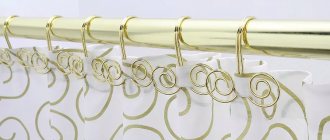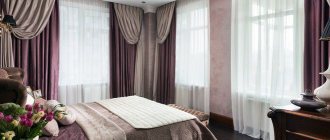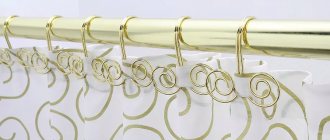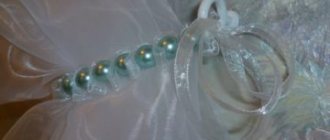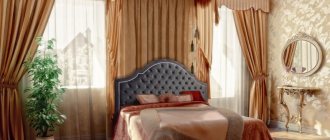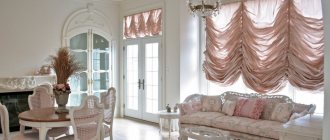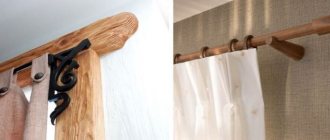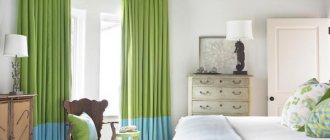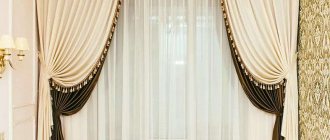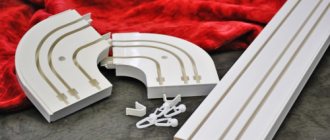Even the most stylish and high-quality curtains offered in stores have one significant drawback: they are mass-produced and do not add individuality to the interior. Therefore, many housewives prefer to sew “clothing” for windows themselves or to order.
The first option is also good because handmade products carry energy that has a positive effect on the overall atmosphere of the house.
The photo shows Roman and Austrian curtains with fringe. This finishing along the bottom edge gives the roller blinds a special elegance.
It is also convenient that even a novice seamstress can make simple curtains, and curtain accessories, such as tassels and fringe, will help give them shine.
What is curtain fringe?
Fringe is a finishing braid, along the edge of which hang fluffy tassels, threads, cords, pendants, etc. It is used to decorate not only curtains, but also bedspreads, pillows, etc. Thanks to it, even the most boring fabric gets a new life and becomes more elegant and interesting.
Most often, curtains are decorated with this decoration, although you can also find braid on sale that will effectively complement light curtains. It is usually sewn to the bottom of the fabric, but, depending on the appearance of the curtains, you can also decorate it with lambrequins and tiebacks.
Key Features
Decorating window openings using textile elements framed with braid, on the edge of which there is a row of threads or pendants, is called fringe decoration.
The purpose of using fringe is to decoratively transform curtains, window openings and the room as a whole. It has no functional use, but makes the room presentable and creates a memorable and elegant atmosphere. Images of rooms decorated with fringed lambrequins prove the above statement.
Where is it used?
Most often, fringe is used to decorate lambrequins , but nowadays it can also be used as an independent element, sewn horizontally, and in some cases vertically.
With its help, curtains are given a sophisticated and elegant look. Quite often, the accessory is used to decorate curtains in a classic interior, but options are also possible. Due to the fact that the main purpose of using fringe is to decorate the room, this element does not carry any functional load.
Using this type of braid for decoration, you can achieve visual highlighting and highlighting of individual parts of the interior, giving them a beautiful and elegant look.
Voluminous curtains made of velvet or silk will be ideally emphasized by correctly selected decor.
Color is also of no small importance; using a contrasting or monochromatic option will impose a certain shade on the entire room as a whole.
It all depends on what you want to achieve - the softness of bed colors or the pomp of crimson.
Silk threads
The silky shine of the fringe will give the room a unique, cozy, festive atmosphere. It is used both for edging the edges of fabrics and for making curtain ties.
You can buy natural silk threads separately, and then crochet a lace ribbon from them yourself. Such a decoration can become a masterpiece of handicraft, a real family heirloom.
Existing types
Today you can find a wide variety of fringes on sale (examples in the photo). It can be either plain or colored, made from synthetic or natural threads. The following types are distinguished:
- split - with a trimmed edge;
- tinsel - with decorative twisted threads attached to the head;
- block - consisting of blocks of different colors;
- fan-shaped - scalloped or with curly edges.
Depending on the material used, fringe can be:
- thread - a classic version of the product, looks like braid with tall threads;
- with tassels - the edge of the braid is trimmed not only with threads, but also with tassels;
- with pompoms - braid with balls in the form of pompoms;
- with pendants - with shells, rhinestones, beads and beads, plastic products;
- from cords;
- with bugles - with hanging shiny stones.
Until now, fringe is identified with classical or oriental interior styles. And yet, the variety of its types will certainly allow you to find something interesting and suitable for other styles. Including for country and modern.
Mounting features
The classic mounting option is along the bottom section of the curtain, but other placement methods also look good. Experts advise adding iridescent fringe to the edge. Another eye-catching design element will be the fringe, lowered with ribbons. French curtains framed with sparkling fringe are perfect for banquet rooms.
Beads and glass beads serve as complements - they add elegance and richness to the overall design of the curtains. Lambrequins are often replaced by long threads and massive pendants, which creates an incredibly rich combination. Solid rooms look very rich if the curtains are finished with such braid.
Purpose
The use of fringe in finishing curtains performs certain tasks:
- the monotonous pattern on the curtain material, as well as its complete absence, can be diluted by sewing on decorative braid;
- with the help of such braid you can strengthen and secure the drapery;
- beautiful fringe will highlight the colors of the fabric or create a festive mood. Depending on the desired effect, this element is selected to match the curtains or in contrast to them. The braid, chosen to match the prevailing palette, will create an atmosphere of integrity;
- braid with small tassels sewn along the bottom edge of the curtains visually stretches the curtain and at the same time eliminates wrinkles;
- finishing in this way gives the curtains a solemn look and highlights the window opening.
- fringe for curtains in some cases helps to hide unevenness or unsightly seams.
Design options
Brushes are mainly used to decorate lambrequins or curtain ties, although they can become a self-sufficient interior decoration. For example, there are tassels decorating the cushions on the sofa that complement the curtains.
The color can be any - to match the canvas or contrasting. Golden beige tassels look great against a dark blue or brown background. On light beige curtains, black or bright decorations that repeat the interior colors look organic. To tie up curtains in delicate pastel colors, twisted cords (garters for curtains) with tassels at the ends, painted in metallic colors, are suitable as tiebacks.
Selection parameters
There are many variations in finishing curtains with similar fittings. As a rule, only natural and noble fabrics are used in this type of decor. The braid made of silver and golden threads looks quite elegant. The best option would be a combination of different shades and colors of fringe.
When choosing this decorative decoration, you should start from the type of curtains themselves. Heavy fringe with large tassels will suit thick and heavy curtains, while light and elegant fittings look more organic with airy fabrics.
Lately, designers are increasingly paying attention to fringe with rhinestones and beadwork. Such fittings can elevate any type of curtains and add exquisite charm to the interior of the room. Properly selected light will be able to reveal new facets of this decorative decoration and give a luxurious and solemn look to the room.
When choosing fringe, you should take into account the interior design of the room and the overall style. Such fittings will look out of place in a minimalist style or in a nursery. When decorating with fringe, you should also keep in mind the density and type of curtains. To give the most formal look, you can use fringe with rhinestones or bugles.
Styles
Decorating curtains with fringe is typical for different styles, but you can especially often find it in classic and oriental interiors. Metallic braid fits perfectly with chromed metal cornices in high-tech style. Curtains in Country style are often decorated with lace fringe made of cotton, and in a nursery, ribbons with plastic fish or shells in sea green color or with bells would be appropriate.
Fringe decor is possible in different styles:
- Victorian;
- Provence;
- eastern;
- classic;
- Baroque;
- Rococo;
- Empire;
- Modern.
Tassels on the curtains
Curtains decorated with tassels have a long history. It is believed that this decorative element first appeared in Ancient Rome. The revival of fashion occurred during the Renaissance, it happened in France. The golden age of brushes was the 17th century. At this time, they were made everywhere from a variety of materials: wool, cotton, silk.
Not only curtains with furniture were decorated with tassels, but also any textile items, incl. clothes with shoes. It can be argued that brushes are currently experiencing a new renaissance. This practical accessory was undeservedly forgotten, as evidenced by numerous examples of the use of brushes by modern designers in a variety of interiors.
Place in the interior
Curtains with fringe immediately attract attention and are appropriate in different rooms:
- For the bedroom, you can choose blue curtains, the edges of which are decorated with gold fringe. The same decor is appropriate on lambrequins. A green velvet curtain with golden tassel decoration goes well.
- In the living room, a thread fringe pattern will look great on sheer tulle. The scoop and lambrequin are also trimmed with it. To create an oriental interior in the living room, the window space must be supplemented with sliding curtains made of red fabric with gold monograms and the same golden fringe along the edge.
- In the kitchen, as a rule, short roller blinds hang, but Roman and roller blinds are also found. If all these curtains are trimmed with fringe along the edges, it will turn out very funny and at the same time elegant.
Expert commentary
Vladislav Dobronravov
Leading technical specialist at Okna-Media company
A bedroom or living room in an oriental style can be decorated with bugle bead fringe. Elite fringe made of beautiful heavy threads can decorate velvet curtains in the Empire style.
In the interior, fringe is present not only on curtains; it can be used to decorate pillows, bedspreads, tablecloths, and napkins. With the help of such decor, you can achieve unity of style throughout the interior.
Braid decor often borders heavy fabrics. However, modern manufacturers produce many options for lightweight fringe that will not weigh down the air curtain. The most common place for attaching tape is the bottom edge of curtains or curtains. The next most popular is the lambrequin and tiebacks.
Designers advise decorating with massive fringe, which has tassels or pompoms, very dense fabrics. This will look uniform and will also physically stretch the fabric, smoothing out wrinkles and unevenness. Light curtains are decorated with light silver or gold braid; this technique will add purity and style to the image.
Examples of decorating curtains
The combination of fabric with bamboo, plastic, wooden elements, tassels, pompoms, and bells is gaining popularity. The main thing is not to overdo it with decorations, so that everything together does not turn into a rough, vulgar heap. The first rule is to select weightless decorations for thin openwork curtains, and heavy ones for massive curtains.
